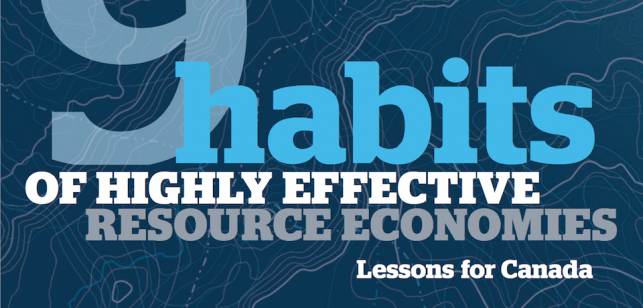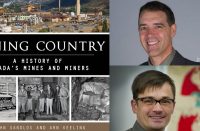Canada largely owes its economic development to natural resources, the vast and (theoretically) sustainable resources like lumber, fish, minerals, agriculture and energy in the form of oil and natural gas. Borrowing liberally from Harold Innis’s iconic The Fur Trade in Canada, hewers of wood and drawers of water we were, and in many ways, we remain.
Canada largely owes its economic development to natural resources, the vast and (theoretically) sustainable resources like lumber, fish, minerals, agriculture and energy in the form of oil and natural gas. Borrowing liberally from Harold Innis’s iconic The Fur Trade in Canada, hewers of wood and drawers of water we were, and in many ways, we remain.
We’re just getting much more sophisticated – at both hewing that wood (we call it sustainable forestry, now) and drawing that water (mostly for hydroelectric and agricultural purposes these days, and oil sands oil production).
The latest reportfrom the Canadian International Council, The 9 Habits of Highly Effective Resource Economies, argues that Canada cannot become a resource superpower by accident, but only through careful planning. However, the main thrust of the report can be summed up by a prominent quote by former Industry Minister Jim Prentice:
“There’s no shame hewing wood and drawing water as long as you are the best in the world at it.”
Before 2003, it appeared Canada was ashamed of its past, as it didn’t appear as if Canadians wanted to wander down that path any longer, having spent century’s doing so already. The heady dot com years of the late 1990s promised a Canada following in America’s footsteps to develop technology and communications as the best and brightest path to prosperity.
“Pumping oil, cutting wood, and extracting minerals were largely regarded as part of an economy best left behind as Canada raced toward a glittery high-tech future,” writes report author Madelaine Drohan, Canadian correspondent for The Economist.
But growing demand from India and China for what Canada has in abundance – the natural resources that stretch across 5,500 km of land from sea to sea to sea – put resources back in the spotlight, coinciding with a ramping up in production of the Alberta oil sands and resulting in what Statistics Canada so aptly called “the revenge of the old economy” in 2006.
Just how dependent is Canada on its natural resources for economic success? Extremely. Drohan provides the details, saying “last year, the top Canadian merchandise export to every one of its major trading partners was a natural resource.”
Top Exports from Canada to its largest trading partners:
- United States – crude petroleum;
- China – wood pulp;
- Japan and South Korea – coal; and
- Europe (as a whole) – precious metals and alloys.
“As far as the rest of the world is concerned, Canada has returned to its resource roots,” she writes.
Yet in another way the reliance on resource extraction has not had the immediate impact on jobs one might expect. Drohan points out that only 337,000 of Canada’s 17 million jobs are in resource sectors (according to Statistics Canada), a mere 1.98 per cent of total jobs available. Yet this number rises when you factor in the people employed in sectors built around resource production.
The report can be distilled into nine key recommendations for movers and shakers in Ottawa and beyond who inform Canadian resource policy, including calls for a revenue-neutral carbon tax; greater collaboration between industry, government and academe; treating natural resources as capital to be invested rather than income to be spent; diversify its export markets; and developing a national resource plan.
That plan, Drohan adds, should be convened and led by the federal government who must take pains to avoid dominating the conversation.
“The sky will not fall if Canada continues its current ad hoc approach to resource development policy in its broadest sense,” Drohan concludes. “But without strong leadership and collaboration we risk losing an opportunity to become a real resource superpower, one capable of responsible and efficient stewardship that Canadians can be proud of and other countries will want to emulate.”
Try as we might to move beyond the past that defines Canadians as a people, we can’t seem to let it go. Manufacturing sectors take time to build, to provide the right incentives for business, attract investors and find clients in a global marketplace. But in some respects, however we may try and move on, resources remain a fall back in tougher economic times, and a stable venture when things are going well.
Moreover, we have long memories when things go wrong. Just ask Justin Trudeau, crisscrossing the country on a tour as he seeks the Liberal Party of Canada leadership. In Calgary recently, Trudeau had to remind his audience he was ten years old when his father introduced the much hated (at least in the West) National Energy Program (1980-1985) that gave the federal government control over energy prices, among other stipulations.
(Let the Eastern bastards freeze, came the reply from the West.)
But in a move to separate himself from his father’s contentious plan, the younger Trudeau told crowds that “It is wrong to use our natural wealth to divide Canadians against one another,” he said. “It was the wrong way to govern Canada in the past. It is wrong today. And it will be wrong in the future.”
Drohan might agree. But moving beyond the historic divisions that still cast a long political shadow in this country and towards the new national resource plan she calls for is easier said than done.
Check out the report and accompanying maps yourself and let us know what you think of the CIC’s recommendations for becoming a “resource superpower,” from more environmental responsibility and a carbon tax to welcoming more immigrants as permanent residents rather than temporary workers.
The Current Events blog focuses on a wide array of environmental current events in Canada, ranging from issues of politics and public policy to energy, natural resources, and environmental science.
Andrew Reeves is the Editor-in-Chief of Alternatives Journal. Overrun, his book about Asian carp in North America, will be published in Spring 2019 by ECW Press. His work has also appeared in the Globe & Mail, Spacing and Corporate Knights. Follow him on Twitter.













